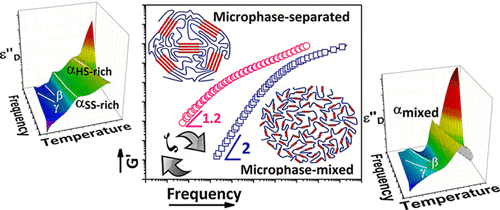当前位置:
X-MOL 学术
›
Macromolecules
›
论文详情
Our official English website, www.x-mol.net, welcomes your
feedback! (Note: you will need to create a separate account there.)
How Does Microstructural Design Affect the Dynamics and Rheology of Segmented Polyurethanes?
Macromolecules ( IF 5.1 ) Pub Date : 2020-06-24 , DOI: 10.1021/acs.macromol.0c00998 Hamid Reza Heydarnezhad 1, 2 , Naser Mohammadi 1 , Arantxa Arbe 2 , Angel Alegria 2, 3
Macromolecules ( IF 5.1 ) Pub Date : 2020-06-24 , DOI: 10.1021/acs.macromol.0c00998 Hamid Reza Heydarnezhad 1, 2 , Naser Mohammadi 1 , Arantxa Arbe 2 , Angel Alegria 2, 3
Affiliation

|
To molecularly investigate the role of the microstructure in controlling the dynamics of segmented polyurethanes (PUs), a series of them were systematically designed, synthesized, and experimentally scrutinized. Broadband dielectric spectroscopy and rheometry along with small-angle X-ray scattering and differential scanning calorimetry were applied to provide insights into molecular origins, particularly the role of transitional friction coefficients (ζ), affecting dynamics and rheology of the various microstructures of PUs. In this way, first, the effective ζs of model PUs were extracted from their rheological data using the Bueche–Ferry procedure. Second, the experienced ζ by the hard and soft segments (SS and HS) in pure components and resultant PUs were calculated using BDS data and were applied in a Rouse model based methodology to estimate the effective ζ. Finally, the obtained effective ζ from rheometry (ζeff) and BDS (ζeffRouse) were compared at the same temperatures. For highly microphase-mixed system with liquid-like terminal behavior, ζeffRouse was consistent with ζeff. For microphase-separated PUs with their nonterminal behavior, however, a fairly large difference between ζeff and ζeffRouse was found. A universal curve was also prepared to illustrate the relationship between the dynamics and microstructural features of model PUs. According to these results and the SAXS data analyses, the frictional forces acting at the interfaces between SS-rich and HS-rich phases were suggested as a main origin for the deviation from terminal Rouse-like dynamics in the microphase-separated PUs, while bare friction coefficients in their pure components play an insignificant role in the dynamics of these systems.
中文翻译:

微结构设计如何影响嵌段聚氨酯的动力学和流变性?
为了从分子角度研究微结构在控制分段聚氨酯(PU)动力学方面的作用,对其中的一系列进行了系统的设计,合成和实验研究。宽带介电谱和流变仪以及小角度X射线散射和差示扫描量热法可用于深入了解分子起源,特别是过渡摩擦系数(ζ)的作用,影响PU各种微结构的动力学和流变性。通过这种方式,首先,使用Bueche-Ferry程序从模型流变数据中提取模型PU的有效ζ。第二,使用BDS数据计算纯组分中硬和软链段(SS和HS)和所得PU经历的ζ,并将其应用于基于Rouse模型的方法中,以估算有效ζ。最后,从流变学获得的有效ζ(ζeff)和BDS(ζeff Rouse)在相同温度下进行了比较。对于具有类似液体的终端行为高度微相混合系统,ζ EFF劳斯用ζ一致EFF。对于微相分离的PU与他们的非终结行为,但是,ζ之间相当大的差异EFF和ζ EFF劳斯被找到。还准备了一条通用曲线来说明模型PU的动力学与微观结构特征之间的关系。根据这些结果和SAXS数据分析,建议在富SS相和富HS相之间的界面上作用的摩擦力是微相分离的PU中终端Rouse样动力学偏离的主要来源,而裸露纯组分中的摩擦系数在这些系统的动力学中起着微不足道的作用。
更新日期:2020-07-14
中文翻译:

微结构设计如何影响嵌段聚氨酯的动力学和流变性?
为了从分子角度研究微结构在控制分段聚氨酯(PU)动力学方面的作用,对其中的一系列进行了系统的设计,合成和实验研究。宽带介电谱和流变仪以及小角度X射线散射和差示扫描量热法可用于深入了解分子起源,特别是过渡摩擦系数(ζ)的作用,影响PU各种微结构的动力学和流变性。通过这种方式,首先,使用Bueche-Ferry程序从模型流变数据中提取模型PU的有效ζ。第二,使用BDS数据计算纯组分中硬和软链段(SS和HS)和所得PU经历的ζ,并将其应用于基于Rouse模型的方法中,以估算有效ζ。最后,从流变学获得的有效ζ(ζeff)和BDS(ζeff Rouse)在相同温度下进行了比较。对于具有类似液体的终端行为高度微相混合系统,ζ EFF劳斯用ζ一致EFF。对于微相分离的PU与他们的非终结行为,但是,ζ之间相当大的差异EFF和ζ EFF劳斯被找到。还准备了一条通用曲线来说明模型PU的动力学与微观结构特征之间的关系。根据这些结果和SAXS数据分析,建议在富SS相和富HS相之间的界面上作用的摩擦力是微相分离的PU中终端Rouse样动力学偏离的主要来源,而裸露纯组分中的摩擦系数在这些系统的动力学中起着微不足道的作用。











































 京公网安备 11010802027423号
京公网安备 11010802027423号